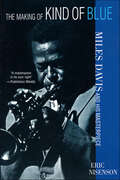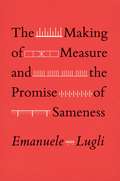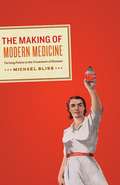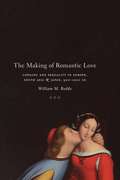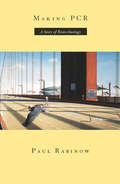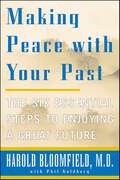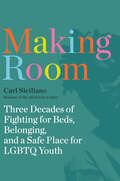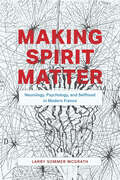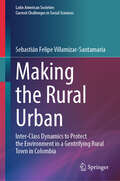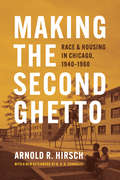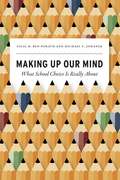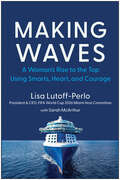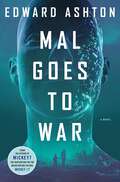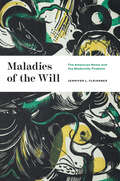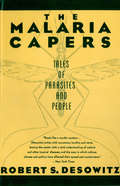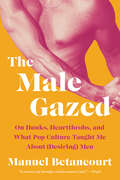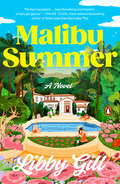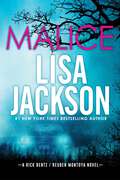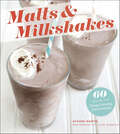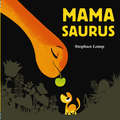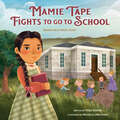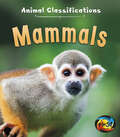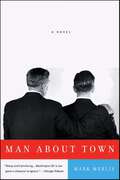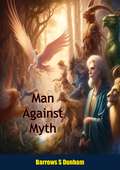- Table View
- List View
The Making of Kind of Blue: Miles Davis and His Masterpiece
by Eric NisensonFrom the moment it was recorded more than 40 years ago, Miles Davis's Kind of Blue was hailed as a jazz classic. To this day it remains the bestselling jazz album of all time, embraced by fans of all musical genres. The album represented a true watershed moment in jazz history, and helped to usher in the first great jazz revolution since bebop.The Making of Kind of Blue is an exhaustively researched examination of how this masterpiece was born. Recorded with pianist Bill Evans, tenor saxophonist John Coltrane, composer/theorist George Russell and Miles himself, the album represented a fortuitous conflation of some of the real giants of the jazz world, at a time when they were at the top of their musical game. The end result was a recording that would forever change the face of American music.Through extensive interviews and access to rare recordings Nisenson pieced together the whole story of this miraculous session, laying bare the genius of Miles Davis, other musicians, and the heart of jazz itself.
The Making of Measure and the Promise of Sameness
by Emanuele LugliAn interdisciplinary history of standardized measurements. Measurement is all around us—from the circumference of a pizza to the square footage of an apartment, from the length of a newborn baby to the number of miles between neighboring towns. Whether inches or miles, centimeters or kilometers, measures of distance stand at the very foundation of everything we do, so much so that we take them for granted. Yet, this has not always been the case. This book reaches back to medieval Italy to speak of a time when measurements were displayed in the open, showing how such a deceptively simple innovation triggered a chain of cultural transformations whose consequences are visible today on a global scale. Drawing from literary works and frescoes, architectural surveys, and legal compilations, Emanuele Lugli offers a history of material practices widely overlooked by historians. He argues that the public display of measurements in Italy’s newly formed city republics not only laid the foundation for now centuries-old practices of making, but also helped to legitimize local governments and shore up church power, buttressing fantasies of exactitude and certainty that linger to this day. This ambitious, truly interdisciplinary book explains how measurements, rather than being mere descriptors of the real, themselves work as powerful molds of ideas, affecting our notions of what we consider similar, accurate, and truthful.
The Making of Modern Medicine: Turning Points in the Treatment of Disease
by Michael BlissAt the dawn of the twenty-first century, we have become accustomed to medical breakthroughs and conditioned to assume that, regardless of illnesses, doctors almost certainly will be able to help—not just by diagnosing us and alleviating our pain, but by actually treating or even curing diseases, and significantly improving our lives. For most of human history, however, that was far from the case, as veteran medical historian Michael Bliss explains in The Making of Modern Medicine. Focusing on a few key moments in the transformation of medical care, Bliss reveals the way that new discoveries and new approaches led doctors and patients alike to discard fatalism and their traditional religious acceptance of suffering in favor of a new faith in health care and in the capacity of doctors to treat disease. He takes readers in his account to three turning points—a devastating smallpox outbreak in Montreal in 1885, the founding of the Johns Hopkins Hospital and Medical School, and the discovery of insulin—and recounts the lives of three crucial figures—researcher Frederick Banting, surgeon Harvey Cushing, and physician William Osler—turning medical history into a fascinating story of dedication and discovery.Compact and compelling, this searching history vividly depicts and explains the emergence of modern medicine—and, in a provocative epilogue, outlines the paradoxes and confusions underlying our contemporary understanding of disease, death, and life itself.
The Making of Romantic Love: Longing and Sexuality in Europe, South Asia & Japan, 900–1200 CE (Chicago Studies In Practices Of Meaning Ser.)
by William M. ReddyIn the twelfth century, the Catholic Church attempted a thoroughgoing reform of marriage and sexual behavior aimed at eradicating sexual desire from Christian lives. Seeking a refuge from the very serious condemnations of the Church and relying on a courtly culture that was already preoccupied with honor and secrecy, European poets, romance writers, and lovers devised a vision of love as something quite different from desire. Romantic love was thus born as a movement of covert resistance. In The Making of Romantic Love: Longing and Sexuality in Europe, South Asia, and Japan, William M. Reddy illuminates the birth of a cultural movement that managed to regulate selfish desire and render it innocent—or innocent enough. Reddy strikes out from this historical moment on an international exploration of love, contrasting the medieval development of romantic love in Europe with contemporaneous eastern traditions in Bengal and Orissa, and in Heian Japan from 900-1200 CE, where one finds no trace of an opposition between love and desire. In this comparative framework, Reddy tells an appealing tale about the rise and fall of various practices of longing, underscoring the uniqueness of the European concept of sexual desire.
Making PCR: A Story of Biotechnology
by Paul RabinowMaking PCR is the fascinating, behind-the-scenes account of the invention of one of the most significant biotech discoveries in our time—the polymerase chain reaction. Transforming the practice and potential of molecular biology, PCR extends scientists' ability to identify and manipulate genetic materials and accurately reproduces millions of copies of a given segment in a short period of time. It makes abundant what was once scarce—the genetic material required for experimentation.Making PCR explores the culture of biotechnology as it emerged at Certus Corporation during the 1980s and focuses on its distinctive configuration of scientific, technical, social, economic, political, and legal elements, each of which had its own separate trajectory over the preceding decade. The book contains interviews with the remarkable cast of characters who made PCR, including Kary Mullin, the maverick who received the Nobel prize for "discovering" it, as well as the team of young scientists and the company's business leaders. This book shows how a contingently assembled practice emerged, composed of distinctive subjects, the site where they worked, and the object they invented. "Paul Rabinow paints a . . . picture of the process of discovery in Making PCR: A Story of Biotechnology [and] teases out every possible detail. . . . Makes for an intriguing read that raises many questions about our understanding of the twisting process of discovery itself."—David Bradley, New Scientist "Rabinow's book belongs to a burgeoning genre: ethnographic studies of what scientists actually do in the lab. . . . A bold move."—Daniel Zalewski, Lingua Franca "[Making PCR is] exotic territory, biomedical research, explored. . . . Rabinow describes a dance: the immigration and repatriation of scientists to and from the academic and business worlds."—Nancy Maull, New York Times Book Review
Making Peace with Your Past: The Six Essential Steps to Enjoying a Great Future
by Harold H. Bloomfield Phil GoldbergDo You: Harbor guilt or grudges from past relationships? Feel plagued by thoughts of regret? Think "Oh, no, not again!" when personal problems arise? Wonder why life hasn't turned out the way you wanted? Feel anxious or depressed about your future? Seem to be less happy as time goes by?If you answered yes to even one of these questions, this book can help you make peace with your past -- here and now.The past lives on in everything we think, feel, say, and do. Medical studies show that adults who've had adverse or traumatic past experiences are much more vulnerable to life-threatening illnesses such as cancer and heart disease. Now, world-renowned psychiatrist Dr. Harold Bloomfield, bestselling author of Making Peace with Your Parents and Making Peace with Yourself, offers practical, scientifically proven techniques that can help you heal the wounds of the past; transform feelings of pain, shame, and blame into high self-worth; and reawaken to the magic and joy of being alive.
Making Room: Three Decades of Fighting for Beds, Belonging, and a Safe Place for LGBTQ Youth
by Carl SicilianoFrom a pioneering advocate for LGBTQ youth, a gripping, impassioned account of how an unhoused queer youth's murder compelled him to create the nation's largest housing program for homeless LGBTQ teens. &“A gut-wrenchingly poignant real-life saga . . . an unputdownable account of what it looks like when compassion is harnessed to funding and policy.&”—Tim Murphy, author of Christodora and Speech Team What power does a long-disenfranchised community hold to transform the treatment of its most abused members? How can we locate that power? Carl Siciliano met Ali Forney—a Black nonbinary teenager known for fierce loyalty to friends and an unshakeable faith that &“my God will love me for who I am&”—in 1994 while working at a daytime center for homeless youth in New York City. Nineteen years old, Forney was one of thousands Siciliano encountered who had been driven from their homes by rejecting families, forced to struggle in the streets due to homophobic and transphobic violence in the shelters. Then Forney was murdered, a moment of horror and devastation that exposed the brutality that teenagers like Forney faced in a city marked by gentrification, racist policing, and the onslaught of the AIDS epidemic. Anguished by Forney&’s loss, Siciliano fought to create homes where unhoused queer teens could live safely, with their human dignity at last affirmed, while he helped lead a movement that compelled New York City to invest millions of dollars in kids who&’d been ignored for decades. Siciliano writes with loving affection for Forney and many other queer teens, showing deep respect for their wisdom, courage, and spiritual integrity. Their stories illuminate the harsh realities faced by hundreds of thousands of LGBTQ youths suffering from homelessness across our nation. And, exposing the political and religious forces that continue to endanger LGBTQ youths, he makes a clarion call for their protection. Written with heart and profound insight, Making Room is a landmark personal narrative, bringing to life an untold chapter of LGBTQ history and testifying to the power of community, solidarity, and the human spirit.
Making Spirit Matter: Neurology, Psychology, and Selfhood in Modern France
by Larry Sommer McGrathThe connection between mind and brain has been one of the most persistent problems in modern Western thought; even recent advances in neuroscience haven’t been able to explain it satisfactorily. Historian Larry Sommer McGrath’s Making Spirit Matter studies how a particularly productive and influential group of nineteenth- and early twentieth-century French thinkers attempted to solve this puzzle by showing the mutual dependence of spirit and matter. The scientific revolution taking place at this point in history across disciplines, from biology to psychology and neurology, located our mental powers in the brain and offered a radical reformulation of the meaning of society, spirit, and the self. Tracing connections among thinkers such as Henri Bergson, Alfred Fouillée, Jean-Marie Guyau, and others, McGrath plots alternative intellectual movements that revived themes of creativity, time, and experience by applying the very sciences that seemed to undermine metaphysics and religion. Making Spirit Matter lays out the long legacy of this moment in the history of ideas and how it might renew our understanding of the relationship between mind and brain today.
Making the Rural Urban: Inter-Class Dynamics to Protect the Environment in a Gentrifying Rural Town in Colombia (Latin American Societies)
by Sebastián Felipe Villamizar-SantamaríaThis book takes the small rural town of La Calera, in the outskirts of the Colombian capital of Bogotá, as a case study to analyze how residents from different social classes – wealthier ex-urban newcomers arriving to traditionally peasant and rural areas – interact to decide how nature will be used in the face of further urban expansion. Contrary to the conflicts in other gentrification cases, including those of “green” gentrification, this book shows how newcomers and longtimers in La Calera use environmental concerns to bridge social class rifts and push the state to provide water, public space, and decision-making power. Residents see abundant ecological resources like water and land around them, but they do not have access to aqueducts, green public space or power over planning decisions affecting the distribution of these resources. As a response, and to challenge the state more effectively, newcomers and longtimers create inter-class alliances through what the author calls third nature: the way residents try to both protect and keep using existing ecological goods. To do so, despite high levels of class inequality, residents had a similar goal of protecting ecological resources around them by intervening in the physical and political landscapes against a state that induces scarcity, selectively enforcing environmental policies to the detriment of Calerunos. As cities all around the Global South continue to grow, urban expansion posits a threat to the environment by transforming agricultural and protected areas into denser residential or touristic spaces. Moreover, as natural resources become scarcer in the face of climate change, inequality might further existing environmental privileges and vulnerabilities. By examining closely how Calerunos bridge class inequalities for environmental reasons, this case highlights processes that inform other gentrifying rural spaces around the world.
Making the Second Ghetto: Race & Housing in Chicago, 1940–1960 (Historical Studies of Urban America)
by Arnold R. HirschFirst published in 1983 and praised by the likes of Ta-Nehisi Coates and Thomas Sugrue, Arnold R. Hirsch’s Making the Second Ghetto is the rare book that has only become more piercingly prescient over the years. Hirsch’s classic and groundbreaking work of urban history is a revelatory look at Chicago in the decades after the Great Depression, a period when the city dealt with its rapidly growing Black population not by working to abolish its stark segregation but by expanding and solidifying it. Even as the civil rights movement rose to prominence, Chicago exploited a variety of methods of segregation—including riots, redevelopment, and a host of new legal frameworks—that provided a national playbook for the emergence of a new kind of entrenched inequality. Hirsch’s chronicle of the strategies employed by ethnic, political, and business interests in reaction to the Great Migration of Southern Blacks in the mid-twentieth century makes startingly clear how the violent reactions of an emergent white population found common ground with policy makers to segregate first a city and then the nation. This enlarged edition of Making the Second Ghetto features a visionary afterword by historian N. D. B. Connolly, explaining why Hirsch’s book still crackles with “blistering relevance” for contemporary readers.
Making Up Our Mind: What School Choice Is Really About (History and Philosophy of Education Series)
by Sigal R. Ben-Porath Michael C. JohanekIf free market advocates had total control over education policy, would the shared public system of education collapse? Would school choice revitalize schooling with its innovative force? With proliferating charters and voucher schemes, would the United States finally make a dramatic break with its past and expand parental choice? Those are not only the wrong questions—they’re the wrong premises, argue philosopher Sigal R. Ben-Porath and historian Michael C. Johanek in Making Up Our Mind. Market-driven school choices aren’t new. They predate the republic, and for generations parents have chosen to educate their children through an evolving mix of publicly supported, private, charitable, and entrepreneurial enterprises. The question is not whether to have school choice. It is how we will regulate who has which choices in our mixed market for schooling—and what we, as a nation, hope to accomplish with that mix of choices. Looking beyond the simplistic divide between those who oppose government intervention and those who support public education, the authors make the case for a structured landscape of choice in schooling, one that protects the interests of children and of society, while also identifying key shared values on which a broadly acceptable policy could rest.
Making Waves: A Woman's Rise to the Top Using Smarts, Heart, and Courage
by Lisa Lutoff-PerloFollow the incredible career journey of Lisa Lutoff-Perlo, from her stories as an ambitious young woman to President and CEO of Celebrity Cruises to Vice Chairman for External Affairs at Royal Caribbean Group.A shining testament to the value of being an authentic leader and never sacrificing your integrity, Lutoff-Perlo details the ins and outs of her extraordinary 40-year career. She has risen to the top in a male-dominated industry, while refusing to compromise her values and bringing countless others along with her. Along the way, she ultimately transformed and redefined relaxed luxury cruising with the launch of the bold, innovative Edge Series ships in 2018, which drove unprecedented demand for Celebrity Cruises and propelled the brand&’s financial performance. She climbed the corporate ladder from the very bottom and overcame countless obstacles to reach the top of the cruise industry.In Making Waves, Lutoff-Perlo walks readers through her triumphs, hardships, and learning moments. She breaks down her unique leadership style as the first woman to take the helm as President & CEO of one of the Royal Caribbean Group&’s brands that catapulted Celebrity Cruises to heights no one thought possible, simply by caring deeply for people and putting others first. Readers will learn how she used her superpowers to set herself apart from other leaders—leaving guests and employees in awe of her authenticity and kindness. Individuals from all walks of life will take heart and gain insights they can apply to their own lives and careers: to have integrity, to pay it forward, and to make waves, wherever and whoever they are.
Mal Goes to War
by Edward AshtonThe humans are fighting again. Go figure.As a free A.I., Mal finds the war between the modded and augmented Federals and the puritanical Humanists about as interesting as a battle between rival anthills. He’s not above scouting the battlefield for salvage, though, and when the Humanists abruptly cut off access to infospace he finds himself trapped in the body of a cyborg mercenary, and responsible for the safety of the modded girl she died protecting.A dark comedy wrapped in a techno thriller’s skin, Mal Goes to War provides a satirical take on war, artificial intelligence, and what it really means to be human.
Maladies of the Will: The American Novel and the Modernity Problem
by Jennifer L. FleissnerAn examination of the nineteenth-century American novel that argues for a new genealogy of the concept of the will. What if the modern person were defined not by reason or sentiment, as Enlightenment thinkers hoped, but by will? Western modernity rests on the ideal of the autonomous subject, charting a path toward self-determination. Yet novelists have portrayed the will as prone to insufficiency or excess—from indecision to obsession, wild impulse to melancholic inertia. Jennifer Fleissner’s ambitious book shows how the novel’s attention to the will’s maladies enables an ongoing interrogation of modern premises from within. Maladies of the Will reveals the nineteenth-century American novel’s relation to a wide-ranging philosophical tradition, highly relevant to our own tumultuous present. In works from Moby-Dick and The Scarlet Letter to Elizabeth Stoddard’s The Morgesons and Charles W. Chesnutt’s The Marrow of Tradition, the will’s grandeur and its perversity emerge as it alternately aligns itself with and pits itself against a bigger Will—whether of God, the state, society, history, or life itself. Today, when invocations of autonomy appear beside the medicalization of many behaviors, and democracy’s tenet of popular will has come into doubt, Maladies of the Will provides a map to how we got here, and how we might think these vital dilemmas anew.
The Malaria Capers: Tales Of Parasites And People
by Robert S. Desowitz"Reads like a murder mystery…[Desowitz] writes with uncommon lucidity and verse, leaving the reader with a vivid understanding of malaria and other tropical diseases, and the ways in which culture, climate and politics have affected their spread and containment." —New York Times Why, Robert S. Desowitz asks, has biotechnical research on malaria produced so little when it had promised so much? An expert in tropical diseases, Desowtiz searches for answers in this provocative book.
Maldives: 2024 Article Iv Consultation-press Release; Staff Report; And Statement By The Executive Director For Maldives (Imf Staff Country Reports)
by International Monetary Fund. Asia and Pacific DeptA report from the International Monetary Fund.
The Male Gazed: On Hunks, Heartthrobs, and What Pop Culture Taught Me About (Desiring) Men
by Manuel BetancourtFeaturing deep dives into thirst traps, drag queens, Antonio Banderas, and telenovelas—all in the service of helping us reframe how we talk about (desiring) men—this insightful memoir-in-essays is as much a coming of age as a coming out bookManuel Betancourt has long lustfully coveted masculinity—in part because he so lacked it. As a child in Bogotá, Colombia, he grew up with the social pressure to appear strong, manly, and, ultimately, straight. And yet in the films and television he avidly watched, Betancourt saw glimmers of different possibilities. From the stars of telenovelas and the princes of Disney films to pop sensation Ricky Martin and teen heartthrobs in shows like Saved By the Bell, he continually found himself asking: Do I want him or do I want to be him?The Male Gazed grapples with the thrall of masculinity, examining its frailty and its attendant anxieties even as it focuses on its erotic potential. Masculinity, Betancourt suggests, isn&’t suddenly ripe for deconstruction—or even outright destruction—amid so much talk about its inherent toxicity. Looking back over decades&’ worth of pop culture&’s attempts to codify and reframe what men can be, wear, do, and desire, this book establishes that to gaze at men is still a subversive act.Written in the spirit of Hanif Abdurraqib and Olivia Laing, The Male Gazed mingles personal anecdotes with cultural criticism to offer an exploration of intimacy, homoeroticism, and the danger of internalizing too many toxic ideas about masculinity as a gay man.
Malibu Summer: A Novel
by Libby GillLose yourself in this opposites-attract romance set on a sunny Malibu hillside Ivy Bauer is a young, bright soil scientist and inventor of a game changing organic irrigation system. She&’s on top of the world when, suddenly, her husband is killed in a biking accident. Needing space to grieve, she takes a summer job as a gardener in Malibu. Conrad Reed is a wealthy Hollywood has-been who, after the death of his wife, feels overwhelmed by the care of his anxious stepson Hudson, massive cliffside estate, and deteriorating career. He hopes Ivy will help take at least one thing off his plate. But the bossy, opinionated Ivy isn&’t making things any easier for him. Sparks fly—and not the good kind. But it&’s when Ivy finds the key to Hudson&’s heart that Conrad&’s own heart begins to melt as well—and then the sparks that fly are the ones that kindle the best kind of love affair . . .
Malice (A Bentz/Montoya Novel #6)
by Lisa JacksonIn this twisted thriller from the #1 New York Times bestselling author, featuring New Orleans detectives Rick Bentz and Reuben Montoya, the past comes back to haunt Bentz, and it&’s deadlier and closer to home than ever. The scent is unmistakable—gardenias, sweet and delicate, the same perfume that his beautiful first wife, Jennifer, always wore. Opening his eyes in the hospital room where he&’s recovering from an accident, New Orleans detective Rick Bentz sees her standing in the doorway. Then Jennifer blows him a kiss and disappears. But it couldn&’t have been Jennifer. She died twelve years ago . . . Once out of the hospital, Bentz begins to see Jennifer everywhere, haunting and taunting him, then vanishing without a trace. Could she still be alive? He can&’t tell his new wife, Olivia, about the sightings or his secret fear that he&’s losing his mind—though he knows she suspects something is wrong. But Olivia is also hiding a secret . . . When a copy of Jennifer&’s death certificate arrives in the mail, emblazoned with a red question mark, Bentz follows the postmark trail to Los Angeles. Then the murders begin, each victim a part of Jennifer&’s past, each grisly corpse pointing to Bentz as the prime suspect. Someone&’s been waiting patiently, silently, anticipating Bentz&’s every move. Soon it will be Bentz&’s turn to suffer for his sins. But he won&’t be the only one made to pay the ultimate price. For a diabolical killer has now made Olivia the prime target . . .
Malts & Milkshakes: 60 Recipes for Frosty, Creamy Frozen Treats
by Autumn MartinThis sweet collection of 60 recipes puts a new spin on an old-fashioned treat with comforting dessert drinks from times new and old!Organized into sections covering Soda Fountain Classics, Modern Flavors, and Boozy Shakes, the 60 recipes for inspired shakes and malts utilize classic ingredients like malted milk and homemade syrups, as well as gourmet herbal infusions and exotic spices. And this delicious volume doesn't stop at shakes! Autumn Martin of Hot Cakes Molten Chocolate Cakery adapts recipes for her signature creations for knock-out cookies, ice cream sandwiches, and sundaes. Recipes include: - Peanut Butter Shake- Salted Malted Malt- Passion Fruit Creamsicle Shake- Earl Grey Shake- Peach Cobbler Malt- Bacon-Oatmeal Raisin Cookie Shake- Lemon Curd Raspberry Shake- Chocolate Espresso Whiskey Malt- St-Germain and Huckleberry Shake- Cherry Brandy Shake
Mamasaurus
by Stephan LompThis colorful and reassuring picture book follows Babysaurus on an adventure as he enlists his prehistoric friends to seek his Mamasaurus. Is his Mamasaurus the fastest in the jungle? No. Is she the loudest? No. Is she the best flyer? No! Of course, Mamasaurus has been right there all along. And when Babysaurus needs a little help, she is ready with a big hug and a sweet, leafy snack. For Babysaurus, his Mamasaurus is the best mamasaurus in the world! Stephan Lomp has illustrated several books in his native Germany, and in this debut as both author and artist, he has created a fresh twist on a perennial theme that will win the hearts of little ones and their mamas as they snuggle up to read a new favorite.Plus, this is the fixed-format version, which looks almost identical to the print edition!
Mamie Tape Fights to Go to School: Based on a True Story
by Traci HuahnMeet Mamie Tape, 8-year-old Chinese American changemaker who fought for the right to go to school in San Francisco in the 1880s. Follow Mamie's brave steps and discover the poignant history of her California Supreme Court case Tape v. Hurley.Mamie&’s mom always reminded her a journey of a thousand miles begins with a single step. So when Mamie wanted to go to school, even though Chinese children weren&’t allowed, she took her first step and showed up anyway. When she was turned away at the schoolhouse door, she and her parents took another step: they sued the San Francisco school board…and won! Their case Tape v. Hurley made its way up to the California Supreme Court, which ruled that children of Chinese heritage had the right to a free public school education. But even then, Mamie&’s fight wasn&’t over.Mamie Tape Fights to go to School is the story of one young changemaker&’s brave steps on the long journey to end school segregation in California. It began with a single step.
Mammals (Animal Classifications Ser.)
by Angela RoystonThis fascinating series takes a very simple look at animal classifications, with each book focussing on a different group of animal. This book is about mammals: what they do, how they behave, and how these characteristics are different from other groups of animals. Beautifully illustrated with colorful photographs, the book shows many examples of different types of mammals in their natural environment.
Man About Town: A Novel
by Mark MerlisA congressional adviser and habitué of a cozy circuit of bars inside the Beltway, Joel Lingeman never quite felt middle-aged. At least not until he was abandoned by his partner of fifteen years and suddenly thrust into a dating scene with men half his age and no discernible trace of love handles. But this unexpected hole in his life inspires Joel's search for a 1964 edition ofan Esquire-like magazine that contained a swimsuit ad that obsessed and haunted him throughout his youth. Determined to find out what happened to the model shown in the ad, Joel slowly begins to understand what has happened to his own life. Sexy, smart, and deftly observed, Man About Town is a new twist on the idea that the personal is political and a must read for anyone who's ever wondered what happened to that first crush.
Man Against Myth
by Barrows S Dunham"Man Against Myth" by Barrows S. Dunham is a provocative and insightful exploration into the myths that have shaped human thought and society. First published in the mid-20th century, this book challenges readers to question the accepted truths and societal norms that often go unexamined.Dunham, a philosopher and social critic, meticulously deconstructs various myths that pervade culture, politics, and religion. Through his sharp analysis and engaging prose, he reveals how these myths influence behavior, perpetuate stereotypes, and hinder progress. His work is a call to intellectual liberation, encouraging individuals to think critically and embrace reason over tradition."Man Against Myth" is celebrated for its clarity, wit, and fearless approach to controversial topics. Dunham's arguments are supported by historical examples, making the book not only a critique of myth but also a rich tapestry of human history and thought. His ability to blend philosophy with practical wisdom makes this book a timeless and relevant read.For anyone interested in philosophy, sociology, or simply understanding the forces that shape human belief, "Man Against Myth" offers a compelling and enlightening perspective. Dunham's work remains a significant contribution to the ongoing dialogue about truth, reason, and the power of myth in human society.
